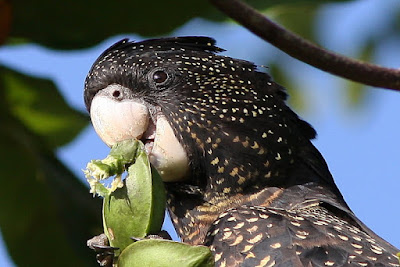Immature Spotless Crake (Porzana tabuensis) peers from out of cover beside a Tyto track. In maturity the drab grey back will give way to chocolate brown. The eyes will glow red. Ditto the legs. Worth waiting to see.
Always worth waiting to see: Rainbow Lorikeet (Trichoglossus haematodus), scratched up from the holdover file.
Ditto this Red-tailed Black-Cockatoo (Calyptorhynchus banksii) crunching into green almond down the road from Tyto.
Updates: Male Comb-crested Jacana stays glued to surviving youngster. Three other families: four, three and two immatures. Plus two youngsters now independent.
Shining Flycatchers still feeding probably three hatchlings.
Subscribe to:
Post Comments (Atom)
Lament for southern Black-throated Finches
Hollow logs for at risk birdies? Nature's nest boxes if you please Oh, such a clever wheeze So gather in twos and threes? Hundreds you w...

-
Hollow logs for at risk birdies? Nature's nest boxes if you please Oh, such a clever wheeze So gather in twos and threes? Hundreds you w...
-
White-faced Heron stands up and begs picture be taken at Tyto. The birds can develop some trust in people, but I've never found any aro...
-
Who gives way on footbridge, Yellow-spotted Monitor or unspotted bird watcher? Naturally, dinkum locals have right-of-way. I step aside, Spo...







Wow! Love that Shining Flycatcher and now I understand why they're called Spotless Crakes.
ReplyDeleteFor some reason (possibily insanity) I didn't believe that spotless crakes really were sans spots. Now I know to trust crake and rail labelling.
ReplyDeleteHi Russell, Snail: Not so sure about trusting names. Spotless Crakes have very strong undertail barring that can look quite spotty. Oz bird names often v confusing, I think.
ReplyDelete